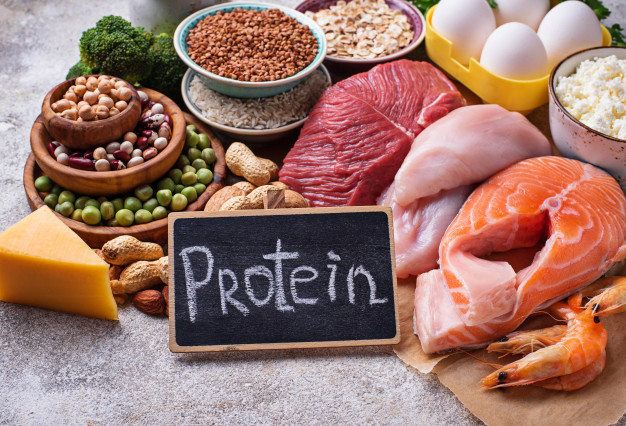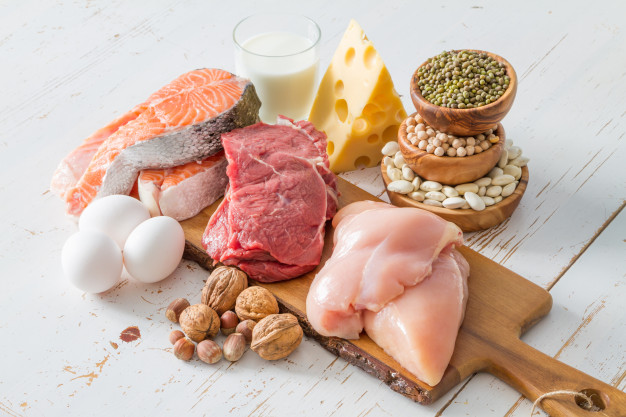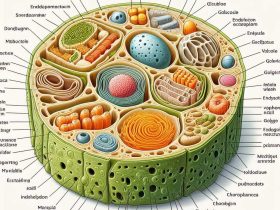Proteins are a type of complex and large molecules that play many important roles in the body. They do most of the work in cells and are need for the function, structure, and regulation of the body’s organs and tissues.
Proteins are made up of thousands or thousands of smaller units called amino acids, which are linked to one another in the form of long chains. Twenty different kinds of amino acids can be combined to make a protein. The series of amino acids determines each protein’s unique 3-dimensional structure and its particular function. Proteins can be detailed according to their large range of functions in the body.
Examples of protein contain the whole classes of important hormones, molecules, among them enzymes, and antibodies.
Proteins are one of the third kind of nutrients used as energy sources by the body, the other two being fat and carbohydrates. Proteins and carbohydrates each offer four calories of energy per gram, while fats produce nine calories per gram.
Classification of Proteins with examples
Classification of proteins is done based on the following:
- Shape
- Constitution
- Nature of molecules
On the basis of shape
Fibrous protein (Scleroprotein):

We can know that these proteins are found in animals and are insoluble in water. Fibrous proteins are repellent to proteolytic enzymes and are exist in threadlike structures to form fibers. Examples of fibrous proteins are:
- Actin
- Arp2/3
- Collagen
- Coronin
- Dystrophin
- Elastin
- F-spondin
- Fibronectin
- Keratin
- Myosin
- Nebulin
- Pikachurin
- Spectrin
- Tau
- Titin
- Tropomyosin
- Tubulin
Globular proteins: These proteins, unlike fibrous proteins which are soluble in water. They are made up of polypeptides that are coiled about themselves to create oval or spherical molecules example insulin, albumin, and hormones like oxytocin, etc.
Examples of globular proteins:

- Albumins
- Alpha globulin
- Beta globulin
- C1-inhibitor
- C3-convertase
- Cadherin
- Carboxypeptidase
- C-reactive protein
- Ependymin
- Factor VIII
- Factor XIII
- Fibrin
- Gamma globulin
- Hemoglobin
- IgA
- IgD
- IgE
- IgG
- IgM
- Integrin
- Myoglobin
- NCAA
- Protein C
- Protein S
- Protein Z
- Protein Z-related protease inhibitor
- Selectin
- Serum albumin
- Serum Amyloid P Component
- Thrombin
- Von Willebrand Factor
Membrane Proteins

Membrane proteins influence several parts including delivering signals within cells, enabling cells to interact, and carrying molecules.
Examples of membrane proteins are:
- CFTR
- C-myc
- Estrogen receptor
- FOXP2
- FOXP3
- Glucose transporter
- Glycophorin D
- Histones
- Hydrolases
- Muscarinic acetylcholine receptor
- MyoD
- Nicotinic acetylcholine receptor
- Oxidoreductases
- P53
- Potassium channel
- Rhodopsin
- Scramblase
- Transferases
High Protein Foods

Here are criteria of foods rich in protein with the number of grams per 100 grams of the food:
- Soya beans – 35.9g
- Cheese – 30.9g
- Venison – 30.21
- Pumpkin seeds – 28.8g
- Lobster – 26.41
- Canned tuna fish – 26.3g
- Tuna fish – 25.6g
- Monkfish – 24g
- Crunchy peanut butter – 24.9g
- Tilapia – 24g
- Skinless chicken breast – 23.5g
- Sunflower seeds – 23.4g
- Orange roughy – 22.64g
- Skinless turkey breast – 22.3g
- Boneless salmon fillets – 21.6g
- Sardines – 21.5g
- Almonds – 21.1g
- Beef fillet – 20.9
- Lamb steak – 19.9g
- Pork chops – 19.3g
- Crabmeat – 18.1g
- Cod – 17.9g
- Shrimp – 17.0g
- Haddock – 16.4g
- Bacon – 15.9g
- Couscous – 15.1g
- Anchovies – 14.5g
- Pork sausages – 13.9g
- Eggs – 12.5g
- Pasta – 12.5g
- Goji berries – 12.3g
- Cottage cheese – 12.2g
- Tofu – 12.1g
- Pepperoni pizza – 11.4g
- Whole grain bread – 11.0g
- Porridge oats – 11.0g
- Baked beans – 9.5g
- Hummus – 7.4g
- Brown rice – 6.9g
- Peas – 5.9g
- Spaghetti – 5.1g
- Yogurt – 4.5g
- Broccoli – 4.2g
- Coconut – 3.33g
- Whole milk – 3.3g
- Asparagus – 2.9g
- Spinach – 2.8g
- Potatoes – 2.1g
- Avocado – 1.9g
- Bananas – 1.2g
- Orange – 1.1g
On the basis of the Constitution
Simple proteins: These proteins are made up of amino acids only example globulins, prolamins, albumins, etc.
Conjugated proteins: These are the complex type of proteins that are combined with the characteristic of non–amino acid substance called a prosthetic group. These are of following types:–
Nucleoproteins: Combination of nucleic acid and Protein
Macerations: Combination of carbohydrates (>4%) and protein
Glycoproteins: Combination of carbohydrates (<4%) and Protein
Chromoproteins: Combination of colored pigments and protein
Lipoproteins: Combination of lipid and protein
Metalloprotein: Combination of metal ions and protein
Phosphoprotein: Combination of proteins and phosphate group.
Derived proteins: When proteins are hydrolyzed by alkalis or enzymes, acids, the degradation of products obtained from them are called derived proteins.
On the basis of nature of Molecules
Acidic proteins: T-proteins exists as anion and contain acidic amino acids. Example blood groups.
Basic proteins: The proteins exist as cations and are rich in basic amino acids example lysine, arginine, etc.
Conclusion
We discussed all the important things of proteins with their functions and examples. If you find this informative and useful, please share your experience with us.






Leave a Reply